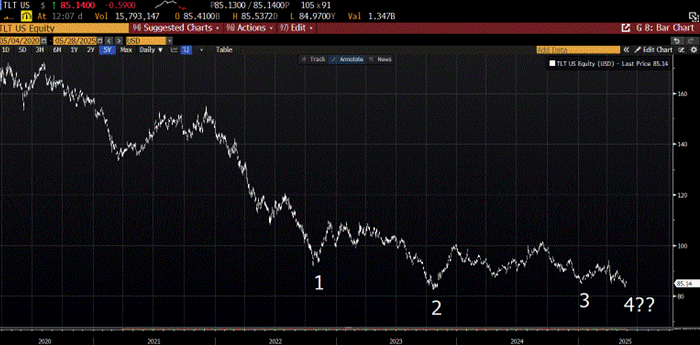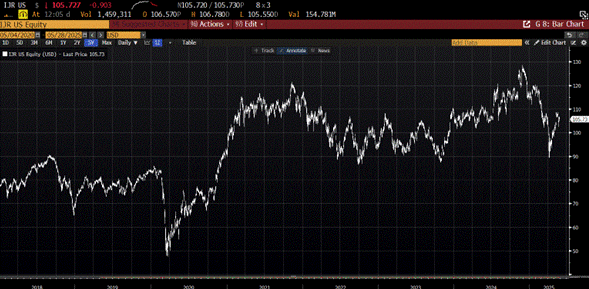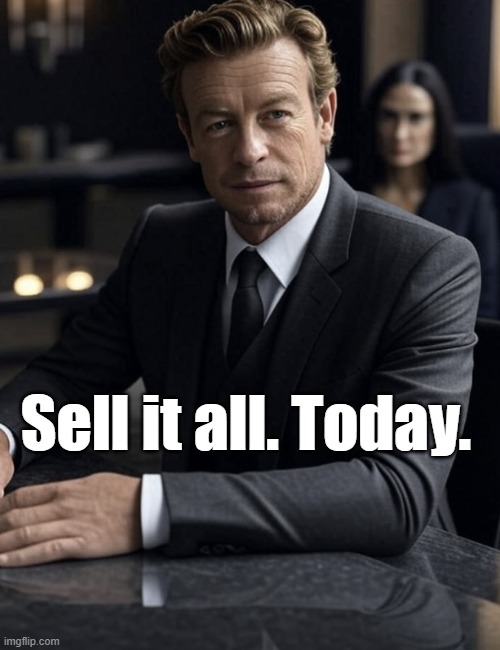I like to think of myself as an aggressive investor. I rarely hedge, and I rarely take my net exposure down below 100. More ideas than capital is how I like to run things; then I press the accelerator through some moderate leverage. Therefore, I find it somewhat odd that I’m writing to you today with nearly a 40% cash balance, which is one of the highest levels of cash in my career. How did I get here??
To start with, I’m really bearish. I’m convinced that the US is on the path from a Developed Market (DM) to an Emerging Market (EM) financial system. This path now seems unavoidable. You can say similar things about Europe, Japan and many other leading, yet overindebted economies. The fact that there is no historical precedent for this concerns me, as it means that most investors are woefully unprepared for what may be coming.
The US now appears to be entering into a fiscal solvency crisis, which is starting to be felt through the Treasury market. This isn’t a call for things to imminently fall out of bed, this process will play out for years to come. However, in our over-levered world, things have a habit of breaking in unpredictable ways. Had anyone ever contemplated Taiwanese life insurers until a few weeks ago??
All I have as an investor is nearly three decades of expensive mistakes. Along the way, I’ve learned two things; when I’m unsure, I cut back, and when it’s not working, I cut back. When the two overlap, I cut back even more. The great thing about running a hedge fund like mine, one where I treat it as if all the capital were personal capital, as opposed to an institutional one with a narrow mandate, is that I have the flexibility to cut back and act like I used to before I ever had a fund. I understand why other investors cannot do this. They don’t want to tell investors that they’re paying fees to own T-Bills. They don’t want to tell analysts that we’re not buying anything right now, so go on holiday. They don’t want to risk a year with no performance and no incentive fees, and they know it’s hard to raise capital when you don’t plan to deploy the capital immediately. However, sometimes, these are the right decisions. You have to take what the market gives you, and sometimes the market only gives you perceived risk.

It’s funny, but Warren Buffett gave everyone the blueprint for what works, yet few listen—you sit with gobs of cash and wait for something to break, then you buy the panic. Sometimes it’s the whole market, and sometimes it’s a single sector, but if you have cash to buy the panic, you’ll make a lot of money. The rest of the time, the market is rather fairly valued. The real great opportunities come during the panics. However, to take advantage of the panics, you need to have lots of excess liquidity in preparation for the panic.

I’m not here saying that I know what happens next, or if a panic is certain, but there are some charts where once you see them, you cannot unsee them. Look at TLT and that $85 level (yeah, I know, only retail trades this thing, but bear with me). We’ve been challenging this level for 3 years now, and there’s no such thing as a quadruple bottom. The market is giving you a narrative, and the narrative is that long-dated rates are going higher, at a time when valuations are asinine and leverage is in the stratosphere. Sure, maybe they can push this thing along—governments have a way of forestalling crises, but the Treasury market is now telling you that we’re into the endgame. When the Fed lowers rates and the long end steepens, it’s symptomatic of the pivot from a DM to an EM funding system. The market is providing a clear narrative if you listen, and I’m certainly listening. I don’t want a lot of exposure if it plays out like I think it may.
Then there’s the question of how the fund is doing. I’m up small (net) this year. It’s no disaster, but I don’t feel like it’s exactly working either. I got some themes right, and some wrong. A lot of themes simply got pushed out a year or two. This is how it often works, but I would be lying to you if I told you I was hitting it out of the park. I’ve done this long enough to know that when it’s not working, the worst thing I can do is to push harder on that string—that’s when accidents occur. Honestly, when it’s not working, it’s often because the market is telling me that a change in market regime is coming.
A look at the S&P 600, which is a basket of the mid-cap names that I tend to traffic in, will tell you that the real economy is sick, as this index really hasn’t gone anywhere since 2021. In fact, it’s only up about 15% since the highs 2018. Now, if you told me that this was a basket of shitcos, I wouldn’t really disagree with you—except to note that most privately owned businesses are also shitcos. The real world is largely devoid of the sorts of high ROIC and moated companies that are leading equity markets higher today. The real world is highly competitive, with low economic returns, along with a lot of cyclicality. A look at a chart of the S&P 600 would tell you that this world has been suffering. In fact, I’d argue that the real economy has been in a recession for many years, only briefly punctuated by hefty COVID stimulus. Now, I see this world rolling over.

I’ve taken exposure down many times in the past, but I usually haven’t been as aggressive in terms of building up cash. I genuinely find it to be a cathartic process as I clear out the names that aren’t working, eliminate ideas that I am less confident in, and take a big reset to the portfolio. It allows me to come back with the ability to think more clearly, as I’m no longer triaging ideas that have stalled out. Instead, I have a blank canvas to deploy capital into. In conjunction with clearing house, I like to step away. Sometimes a few weeks is sufficient. This time, I think it will be longer, the potential storm clouds are warning me to stand back. I’ve thought about it a bunch, and I don’t plan to come back until the markets genuinely call me back. It will be obvious when there’s something to do (outside of some Event-Driven opportunities), and right now, nothing seems particularly obvious, except reducing exposure.
Let me tell you a story. In late 2007, I was unusually bearish. I saw the financial system for what it was—a house of cards. I was short many of the financial institutions that no longer exist. I had a huge cash balance. I was scared that the world was going to have a reset. Unfortunately, I covered my shorts too soon. Then, as the Fed starting cutting rates and threatening QE, I bought gold miners, with a view that they’d have leverage to gold. I got the trade correct, and they had massive leverage to gold as the price of gold roared from $600 to $1900. Unfortunately, in the global margin call of the GFC, my gold names collapsed, before soaring afterwards. It was an amazingly painful experience for me, made worse by the knowledge that I had anticipated what would transpire, yet became a victim anyway.
My lesson from the GFC, was that during a global margin call, everything gets hit. In my mind, Treasuries are the collateral asset that underlies the entire global financial system. They appear to be breaking down. I don’t see how this doesn’t also lead to a global margin call, given all the leverage in the system, all the poorly marked Private Equity and Private Credit, along with the need to refinance all sorts of bonds that were issued during the easy money times following COVID. Despite multiple years with higher rates, the financial markets seem stuck in a time-warp, as no one has had to mark assets to real values, nor roll much in the way of low-cost debt. This cannot last indefinitely. Price discovery will not be kind to many of these assets, especially if it becomes obvious that Treasuries are indeed going lower; increasing funding costs, while reducing equity multiples.

Isn’t this all just part of “Project Zimbabwe??” Sure, it is, but I’m increasingly convinced that we get a global margin call first. Only after governments panic, do we see the blue sky. However, governments will not panic, unless there’s a true crisis—therefore everything points to us entering a crisis. Gradualism, will not fix the imbalances in the global economy.
Will this be like the GFC?? Probably not. Each crisis is unique in its own special way. Governments will fight this one with everything they have, though each time they add liquidity, they’ll actually make the bond problem worse. There is only one solution, which is to have a global agreement to run it hot and devalue the debts. Unfortunately, it seems as though most players are trying to fight their individual debt crises with anti-growth policymaking. Until there’s a new frame of thinking, real economy businesses (the actual core of the economy) will continue to suffer. A handful of mega-cap tech companies have captured investor attention, but they are only a small fraction of the global economy, and they cannot continue to outgrow their own customers, many of whom are suffering.
I invest with one simple rule, “making money is really quite easy, but holding onto it is really quite hard.” I’ve had a good run. The past year has been more difficult. A trend change appears to be afoot, and I haven’t listened enough to the market’s message. Now, it’s time to cut back and hold onto my gains. There will be a time when it’s obvious that there’s something to do, I plan to step back in aggressively at that time. Until then, I’m going to focus on avoiding expensive mistakes. Trust me, the hardest thing to do is to avoid getting sucked back in. The markets want to convince you to give it back. A younger version of myself would willingly contribute my part. As a battle-hardened investor, I know that the best solution is to shut it down, excluding a few names I cannot bear to sell, and then go on the road. I need to distract the mind. I need to get refreshed. When the action starts back again, I think it will be wild. Decades of accumulated financial leverage, and government debt feel like they’re on a precipice.
And if I’m wrong?? What if it’s totally benign, and they find a way to kick the can yet again?? What if I’m wrong to cut back?? For one, I am still running exposure in the things that are working, so I remain invested in what I think will weather this upcoming storm. Second, and even more importantly, the markets are malleable and everlasting. A missed opportunity today, simply leads to another opportunity a few months into the future. I am simply buying optionality. There will always be something to do, and I can always size it up at some later date. Until then, I’m taking my ball and going home…

(PS- If I wanted to tell you what I sold, I’d have told you. Please don’t ask.)


The New Levels…